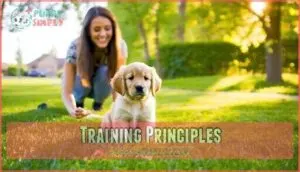This site is supported by our readers. We may earn a commission, at no cost to you, if you purchase through links.
 Teaching your dog to stay is simpler than it sounds, but it takes patience and consistency. Start by asking your dog to sit.
Teaching your dog to stay is simpler than it sounds, but it takes patience and consistency. Start by asking your dog to sit.
Use a firm, calm voice to say "stay," and raise your hand like a stop signal. Take one step back, wait a few seconds, then reward them if they don’t move.
Gradually increase the time and distance, but don’t rush—it’s not a race, and progress depends on your dog. A consistent release word like "okay" helps them know when they’re free to move.
Stay calm, keep sessions short, and remember: practice makes perfect. Ready for advanced tips?
Table Of Contents
- Key Takeaways
- Train Your Dog
- How to Train Stay
- Training Principles
- Step by Step Guide
- Advanced Training Tips
- Frequently Asked Questions (FAQs)
- How do you train a dog to stay?
- How to train a dog to go to its place?
- How to teach a puppy to stay?
- How do you train a new dog?
- How do you teach a dog to stay?
- How long does it take a dog to learn to stay?
- What is the hardest command to teach a dog?
- How long does it take for a dog to learn the stay command?
- What is the best age to start teaching a dog to stay?
- Are there any safety precautions I should take when teaching my dog to stay?
- Conclusion
Key Takeaways
- Start with basic commands like "sit" before introducing "stay" using clear verbal cues and a consistent hand signal.
- Use a release word like "okay" to let your dog know when they’re free to move, avoiding confusion.
- Gradually increase stay duration and distance, rewarding progress with timely praise or treats.
- Train in a calm environment first, then add distractions to build focus and reliability in real-world situations.
Train Your Dog
Training your dog to stay starts with mastering the basics, like sit and down, to build trust and focus.
With clear commands and consistent practice, you’ll teach your dog to stay, improving both safety and control in everyday life.
Basic Commands
Start with basic commands like Sit, Down, Come, Heel, and Fetch to build a solid foundation for dog stay training.
These commands develop focus and trust, making it easier to introduce the stay command later.
Mastering how to train your dog with consistency and patience guarantees obedience.
Remember, clear commands and rewards are key to successful dog training tips!
Importance of Stay
Teaching the stay command isn’t just about rules—it’s about creating a safer, more balanced relationship.
Creating a safer, balanced bond with your dog starts with mastering the stay command through trust, clarity, and consistency.
Whether it’s controlling excitement during dinnertime (manners matter) or ensuring safety first in unexpected situations, dog stay training builds trust and strengthens dog obedience.
This lifesaving skill also shines in dog sports, where precision and focus are key.
One helpful method is positive reinforcement techniques with treats.
Stay puts household obedience into practice daily.
Safety and Control
The stay command isn’t just obedience—it’s life-saving.
In emergencies, teaching your dog to stay prevents escapes or leash reactivity.
It guarantees dog safety during child interaction or in crowded spaces, enhancing public safety.
Imagine preventing chaos with a simple word.
A well-trained stay provides control, letting you manage unpredictable moments calmly.
Mastering stay equals mastering safety and control.
How to Train Stay
To teach your dog the "stay" command effectively, focus on clarity, consistency, and patience. Begin in a calm training environment where distractions are minimal. Ask your dog to sit, then introduce the stay command using a firm voice and clear hand signals.
- Use a release word like “Okay” to signal when the stay is over.
- Keep Reward Timing precise—praise and treat while your dog is in position, not after they move.
- Start with short Stay Durations and gradually increase as your dog progresses.
- Prevent Breaking Stays by reinforcing success and gently resetting them if they move.
Remember, practice is vital. Stay training guides your dog toward safety and obedience, strengthening your bond with them over time. Early training can prevent common puppy issues such as excessive barking.
Training Principles
Teaching your dog to stay requires a clear plan and consistent approach to build their understanding.
By using a release word, staying calm, and progressing gradually, you’ll set them up for success.
Consistent Release Word
How do you make certain your dog knows when the "stay" command ends?
A clear release cue, like "Okay" or "Free," avoids confusion and creates a positive association with the command.
Pair the release word with an immediate gesture or action during dog training stay sessions.
Consistent release word choice helps your dog listen, reinforcing obedience through a simple, effective signal.
Variable Reinforcement
Variable reinforcement keeps your dog motivated during training by mixing up reward schedules.
Instead of rewarding every time, surprise your dog with unexpected rewards.
This strengthens long-term retention and avoids extinction of the stay command.
Positive reinforcement, like treats or praise, helps maintain motivation while keeping the behavior exciting.
Consistent rewards during dog training guarantee your pup confidently masters the stay command with positive reinforcement.
Calm Training Environment
A quiet training space is key to teaching your dog to stay.
Minimize distractions like noise and movement to help them focus.
Controlled temperature guarantees comfort, and short training sessions keep their attention sharp.
Create a positive association by rewarding their efforts consistently.
A calm setting makes the “stay” command easier to learn, reinforcing obedience and trust.
Teaching a "settle" command helps establish crucial impulse control.
Gradual Progression
Start by building the stay command in short, successful increments.
Focus on incremental duration first, slowly adding distance challenges over time.
Once steady, introduce mild distractions like claps or toy noises.
Proofing environments, like parks, solidifies progress.
Regression handling is key—if your dog struggles, reduce duration or distance briefly.
Stay patient; steady dog training progress leads to mastery.
Step by Step Guide
Teaching your dog to stay requires patience and a clear plan. This step-by-step guide breaks the process into simple, manageable actions to help your dog master the command confidently.
Ask Your Dog to Sit
Teaching your dog the "sit" command is the foundation for the stay command. A solid sit sets up for success when learning how to train a dog to stay.
Be patient while introducing it: use clear, calm hand signals alongside verbal instructions.
- Reward quickly for sitting.
- Keep sessions short, focusing on initial duration to build understanding.
Give a Hand Signal
Use your hand to provide a clear visual cue for the stay command.
Keep your palm facing your dog, fingers straight, at their eye level.
Signal consistency is key—use the same hand position each time.
This creates clear communication and reinforces understanding.
Hand signals, paired with verbal commands, help teach dogs to stay and improve focus during training.
Wait a Few Seconds
Once you’ve given the stay command and hand signal, pause for a brief moment—just a second or two.
Timing matters here; short pauses help set clear expectations without overwhelming your dog.
Use calm praise to maintain focus and avoid excitement that could disrupt progress.
These incremental increases in training duration gradually teach your dog self-control, mastering the stay command step by step.
Positive reinforcement, including rewarding with treats, is key to this process.
Reward Your Dog
Once your dog stays for a few seconds, it’s time to reward! Smart reward timing boosts understanding.
Reward during the stay to reinforce success—timing treats perfectly creates lasting understanding and strengthens obedience with positive reinforcement.
Use a mix of dog training rewards, like treats, verbal praise, or affection rewards. Rotate treat types to keep things exciting. Positive reinforcement strengthens behavior.
To find the right incentive, consider exploring various treat options.
Here’s how:
- Reward during the stay.
- Say “Good stay!”
- Use tasty training rewards.
- Praise steadily.
- Stay consistent.
Increase Duration and Distance
After rewarding your dog for staying, it’s time to extend stay time and increase distance.
Take one step back, return quickly, and reward again.
Gradually add challenges like light distractions or a longer wait. These proofing techniques help with real-world application, preparing your dog to handle duration and distance.
Stay patient—consistent practice solidifies the stay command in your training.
Advanced Training Tips
Now that your dog understands the basics of "stay," it’s time to fine-tune their skills with advanced techniques.
By managing distractions and gradually increasing distance and duration, you can guarantee your dog stays focused and reliable in any situation.
Avoid Common Pitfalls
When teaching "stay," avoiding common dog training challenges keeps progress steady.
Don’t repeat commands—it confuses your dog. Avoid luring movements that undo the lesson or punishing mistakes, as it disrupts trust.
Set realistic expectations and use dog training consistency to prevent frustration.
Breaking engagement signals boredom, so stay patient.
Clicker confusion? Time it correctly to reward the behavior, not release, and avoid clicker confusion.
Manage Distractions
Facing environmental challenges like auditory stimuli or visual cues can make the stay command tricky.
Start in a quiet space and gradually add distractions. Many owners find success with dog training products.
Follow these steps:
- Use low-level distractions at first (e.g., toys at a distance).
- Increase complexity, like moving objects closer.
- Reward when your dog listens.
- Train in varied environments for real-world success.
Proofing Stays
Proofing stays means practicing the stay command in real-world scenarios with environmental distractions.
Start in quiet spaces, then add unexpected stimuli like noise or movement.
Keep duration consistency, ensuring your dog holds the stay despite handler position changes, which strengthens focus under distraction.
This process teaches your dog to reliably follow the dog stay command anywhere, anytime.
Combining Duration and Distance
Once your dog’s stays are solid under distractions, combine duration and distance. Start small: step back briefly, then return to reward. Slowly extend your distance while keeping duration short.
Mixing duration milestones with distance challenges builds success.
- Stay close initially, increasing distance gradually.
- Keep distractions minimal while extending duration.
- Use proofing techniques to guarantee reliability.
- Practice real-world applications regularly.
Maintaining Engagement and Focus
Building on combining duration and distance, keeping your dog engaged is equally important.
Use positive reinforcement and adjust session duration to prevent boredom.
Reward timing matters—praise during the stay, not just the release.
Manage dog training distractions with gradual increases.
Practice the stay command in varied environments, making certain focus despite distance or distraction challenges.
Consider using high-value training rewards to maintain focus.
Engagement guarantees obedience sticks and is crucial for successful dog training, which relies on reward timing and gradual increases in difficulty to keep the dog engaged.
Frequently Asked Questions (FAQs)
How do you train a dog to stay?
Start by teaching your dog to sit, then introduce "stay" with a clear command and hand signal.
Gradually increase duration and distance, rewarding success consistently.
Stay patient, and always use a release word for clarity.
How to train a dog to go to its place?
Over 70% of dogs respond well to positive reinforcement.
Teach “place” by guiding your dog to a mat, saying “place,” and rewarding once settled.
Gradually increase time and add distractions to solidify behavior.
How to teach a puppy to stay?
To teach your puppy to stay, use a calm voice, say "stay" with a palm signal, reward after short durations, and release with a word like "okay."
Gradually increase time and distance, rewarding progress.
How do you train a new dog?
Training a new dog takes patience and consistency.
Focus on basic commands like "sit" and "come," use treats and praise for motivation, and keep sessions short.
Gradually add complexity, avoiding frustration for your pup.
How do you teach a dog to stay?
To teach "stay," use a firm, calm voice and pair it with a hand signal.
Reward your dog for holding the position, gradually increasing time, distance, and distractions while ensuring clear release cues, using a firm voice to maintain consistency.
How long does it take a dog to learn to stay?
It typically takes a few weeks to teach a reliable stay, depending on your dog’s age, focus, and consistency in practice.
Short, daily sessions with gradual challenges will help your dog master this command.
What is the hardest command to teach a dog?
The hardest command often depends on your dog’s personality, but "come" can be challenging.
It requires your dog to stop whatever they’re doing and return, even when distractions, instincts, or fear make that difficult.
How long does it take for a dog to learn the stay command?
Mastering the "stay" command can take anywhere from a few days to several weeks, depending on your dog’s age, focus, and consistency in training.
Patience, practice, and rewarding small successes are key.
What is the best age to start teaching a dog to stay?
The perfect time to start teaching "stay" feels like a golden window—around 8 to 12 weeks of age.
Puppies soak up lessons like sponges then, making it easier to build focus and self-control.
Are there any safety precautions I should take when teaching my dog to stay?
Make sure your dog trains in a safe, enclosed area, away from traffic or distractions.
Use a secure leash for control and avoid overwhelming them with too much distance or duration until they’re consistent.
Conclusion
Mastering how to train your dog to stay might seem challenging, but it’s within reach with patience and consistency.
Start small—as trust builds, their focus strengthens. Remember, every second your dog stays is a step closer to success.
Use a clear release word like "okay" to avoid confusion, and don’t skip rewards. Progress at your dog’s pace, not yours.
Over time, with consistent practice, stays will become second nature, enhancing both safety and the bond you share.



















